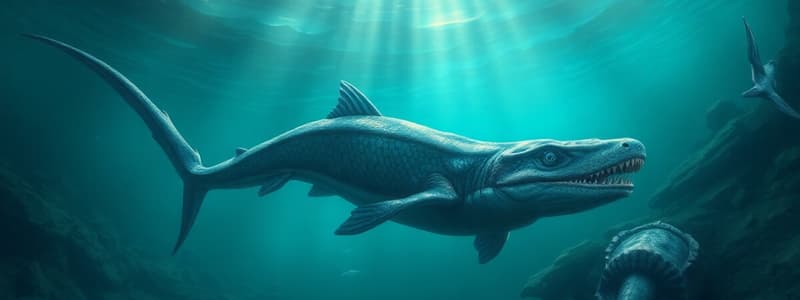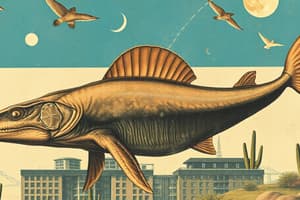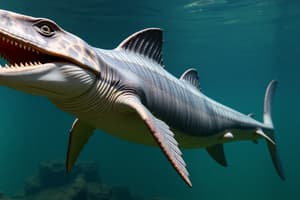Podcast
Questions and Answers
What was a significant evolutionary change in ichthyosaurs over their 100 million years of existence?
What was a significant evolutionary change in ichthyosaurs over their 100 million years of existence?
- They became endothermic like modern mammals.
- They lost their ability to see in dark waters.
- They transformed from a lizard-like shape to a more fish-like shape. (correct)
- They developed limbs to walk on land.
Which feature of ichthyosaurs is notable for enhancing their hunting capability?
Which feature of ichthyosaurs is notable for enhancing their hunting capability?
- Their large size allowed them to intimidate prey.
- Their long, narrow skulls were conducive for catching fish and squid. (correct)
- Their sharp teeth were adapted for crushing hard shells.
- Their paddle-like fins restricted their speed in water.
What is one of the most remarkable physical attributes of ichthyosaurs?
What is one of the most remarkable physical attributes of ichthyosaurs?
- Their vertical tail for enhanced maneuverability.
- Their ability to change color for camouflage.
- Their ability to fly short distances to escape predators.
- Their eyes, which were the largest ever recorded in any animal. (correct)
What hypothesis is suggested regarding the extinction of ichthyosaurs?
What hypothesis is suggested regarding the extinction of ichthyosaurs?
Which statement about the size range of ichthyosaurs is accurate?
Which statement about the size range of ichthyosaurs is accurate?
What is the significance of the ichthyosaur jawbone fossils found by the Reynolds duo?
What is the significance of the ichthyosaur jawbone fossils found by the Reynolds duo?
How does Ichthyotitan severnensis compare in size to other known marine reptiles?
How does Ichthyotitan severnensis compare in size to other known marine reptiles?
In what period did Ichthyotitan severnensis live compared to other ichthyosaurs?
In what period did Ichthyotitan severnensis live compared to other ichthyosaurs?
What is a potential future outcome suggested by the discovery of the jawbones?
What is a potential future outcome suggested by the discovery of the jawbones?
What does the discovery of these ichthyosaur fossils indicate about marine life in the Triassic period?
What does the discovery of these ichthyosaur fossils indicate about marine life in the Triassic period?
What was the primary activity that led to the discovery of the new ichthyosaur species?
What was the primary activity that led to the discovery of the new ichthyosaur species?
How long would the jaw of the newly identified ichthyosaur have measured if it had been complete?
How long would the jaw of the newly identified ichthyosaur have measured if it had been complete?
What relationship did ichthyosaurs have with modern marine animals?
What relationship did ichthyosaurs have with modern marine animals?
What was the length estimated for the recently discovered ichthyosaur species?
What was the length estimated for the recently discovered ichthyosaur species?
What did Justin Reynolds initially identify the fossils as before expert confirmation?
What did Justin Reynolds initially identify the fossils as before expert confirmation?
What percentage of fossil inquiries typically lead to finding an actual specimen versus an odd-shaped rock as mentioned by Dr. Lomax?
What percentage of fossil inquiries typically lead to finding an actual specimen versus an odd-shaped rock as mentioned by Dr. Lomax?
In which period did ichthyosaurs predominantly dominate marine environments?
In which period did ichthyosaurs predominantly dominate marine environments?
What has been stated about the ichthyosaur fossils discovered by the Reynolds team concerning their significance in marine biology?
What has been stated about the ichthyosaur fossils discovered by the Reynolds team concerning their significance in marine biology?
Flashcards
Ichthyosaurs
Ichthyosaurs
Ancient reptile predators that thrived in the oceans alongside dinosaurs.
Triassic Period
Triassic Period
The period when ichthyosaurs first appeared, about 251 million years ago.
Ichthyosaur Eyes
Ichthyosaur Eyes
Huge eyes that helped them see clearly in deep, dark ocean waters.
Ichthyosaur Skull
Ichthyosaur Skull
Signup and view all the flashcards
Late Cretaceous Period
Late Cretaceous Period
Signup and view all the flashcards
What is Ichthyotitan severnensis?
What is Ichthyotitan severnensis?
Signup and view all the flashcards
What kind of creature is Ichthyotitan severnensis?
What kind of creature is Ichthyotitan severnensis?
Signup and view all the flashcards
When did Ichthyotitan severnensis live?
When did Ichthyotitan severnensis live?
Signup and view all the flashcards
How was Ichthyotitan severnensis discovered?
How was Ichthyotitan severnensis discovered?
Signup and view all the flashcards
What is the significance of Ichthyotitan severnensis discovery?
What is the significance of Ichthyotitan severnensis discovery?
Signup and view all the flashcards
What are Ichthyosaurs?
What are Ichthyosaurs?
Signup and view all the flashcards
Who discovered the ichthyosaur?
Who discovered the ichthyosaur?
Signup and view all the flashcards
What did the Reynolds find?
What did the Reynolds find?
Signup and view all the flashcards
Who confirmed the fossil's identification?
Who confirmed the fossil's identification?
Signup and view all the flashcards
What was reconstructed from the collected fossil pieces?
What was reconstructed from the collected fossil pieces?
Signup and view all the flashcards
How big was the newly identified ichthyosaur?
How big was the newly identified ichthyosaur?
Signup and view all the flashcards
Why is the discovery of the giant ichthyosaur important?
Why is the discovery of the giant ichthyosaur important?
Signup and view all the flashcards
What is the new species of ichthyosaur named and when did it live?
What is the new species of ichthyosaur named and when did it live?
Signup and view all the flashcards
Study Notes
Ichthyosaur Overview
- Ichthyosaurs were ancient reptilian predators that ruled the oceans alongside dinosaurs and pterosaurs.
- They first appeared 251 million years ago during the Triassic Period, 20 million years before dinosaurs emerged.
- "Ichthyosaur" means "fish lizard" in Greek, reflecting their initial lizard-like appearance with fins.
- They evolved over 100 million years, becoming more fish-like in shape.
- Ichthyosaurs shared physical similarities with dolphins and whales, but were reptiles.
- They dominated the seas during the Triassic and Jurassic periods (251 to 145 million years ago).
Ichthyosaur Physical Characteristics
- Ichthyosaurs had long, narrow skulls with sharp teeth for catching fish and squid.
- Their eyes were the largest ever recorded in any animal, reaching over 10 inches wide, enabling them to see in deep, dark waters.
- Ichthyosaur sizes varied:
- Some were as small as two feet long.
- The largest known specimen was about 85 feet long. (Possibly 80 ft if the found jaw was complete.)
- They possessed paddle-like fins and a vertical tail, allowing them to swim at speeds over 22 miles per hour despite their size.
Ichthyosaur Discovery
- In spring 2020, Justin and Ruby Reynolds found an ichthyosaur fossil on Blue Anchor Beach in Somerset, England. The fossil was initially only four inches long. (10 cm)
- A second fossil jawbone was found by Paul de la Salle in 2016.
- This discovery confirmed a new ichthyosaur species: Ichthyotitan severnensis.
- Both jawbones date to the end of the Triassic period (around 202 million years ago).
- Dr. Dean Lomax and his team assisted the Reynolds in finding additional pieces.
- Their quest concluded in October 2022, reconstructing a section of the marine reptile's lower jaw, estimated to have measured over six feet (1.8 m) long if complete, potentially an 80-foot (24 m) animal - the equivalent of two buses.
Ichthyotitan severnensis
- Ichthyotitan severnensis was between 72 and 85 feet long, making it one of the largest marine reptiles ever discovered, rivaling the size of a blue whale.
- Ichthyotitan severnensis lived 13 million years later than other known ichthyosaurs.
- It is estimated to have survived until a global mass extinction event approximately 201 million years ago. (Potentially a maximum of 80 feet (24 m).
- Ruby and Justin Reynolds were co-authors on the study published in PLOS One on April 17, 2024.
Ichthyosaur Extinction
- Ichthyosaur dominance ended in the late Cretaceous Period, approximately 25 million years before the asteroid that wiped out dinosaurs.
- The exact cause of their extinction remains unknown.
- Some scientists speculate that severe climate change may have played a role.
Studying That Suits You
Use AI to generate personalized quizzes and flashcards to suit your learning preferences.





